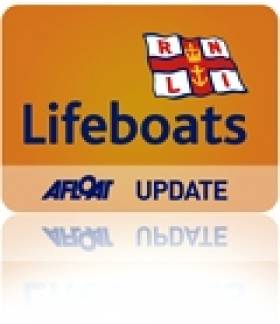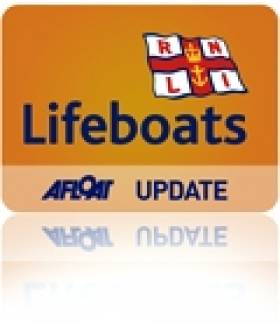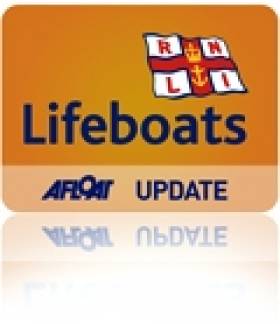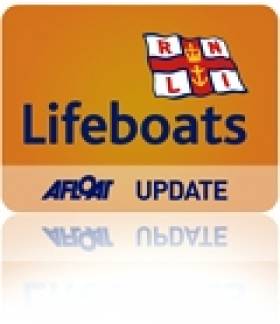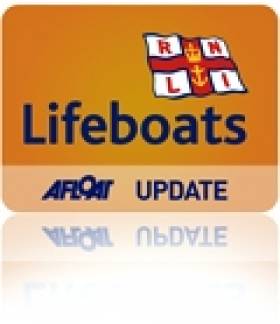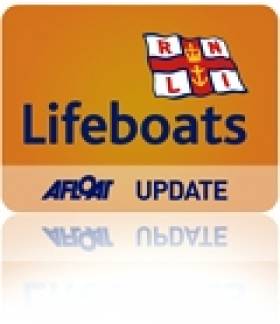Displaying items by tag: RNLI
#RNLI - Rosslare RNLI was called out twice yesterday afternoon (Friday 22 August) to help two separate boats with ropes wrapped around their propellers.
In the space of two hours, both boats – a RIB with two people on board off Carna Pier and a motor cruiser with two on board near Waterford Harbour – were freed by the volunteer lifeboat crew.
The double callout also came on the last day for retiring lifeboat operations manager Michael Doyle.
"Two callouts in one afternoon is a fitting way to say goodbye," said Rosslare RNLI volunteer lifeboat press officer Jamie Ryan.
"Thankfully both call outs were to vessels that had their propellers fouled and no lives were in danger. The lifeboat is there to help anyone in trouble at sea and we were happy to provide assistance in these two cases."
Elsewhere on the east coast, Wicklow RNLI's all-weather lifeboat launched at 4am yesterday morning to the aid a yacht in difficulty eight miles north of Wicklow Harbour.
The yacht was on passage to Greystones when the propeller became fouled in ropes and was unable to make any headway.
"We located the yacht with four people one mile south-east of Greystones Harbour," said coxswain Nick Keogh. "Two lifeboat crew were transferred onto the yacht to assess the situation and they managed to clear the rope obstructing the propeller.
"With the propeller free the yacht was able to make her way into Greystones under its own power."
Crosshaven Lifeboat Joins Major Search For Missing Speedboat
#RNLI - A major rescue operation swung into action early this morning after reports of a speedboat crashing into a channel marker buoy in Cork Harbour en route from Cork city to Crosshaven.
Crosshaven's volunteer lifeboat crew were paged at 45 minutes past midnight to the incident in the lower part of Lough Mahon after the report of a boat with one person on board believed missing after the collision with a navigation buoy.
The area was extensively searched by Crosshaven RNLI along with the Crosshaven Coast Guard boat, the pilot launch Fáilte, Irish Coast Guard helicopter Rescue 117 and coastguard shore teams.
The casualty boat along with its slightly injured owner were eventually located at a marina in Crosshaven. All teams were stood down shortly before 3.30am this morning.
Crosshaven's lifeboat crew on this service were helm Ian Venner, Vince Fleming and Kieran Coniry.
Naming Ceremony For Helvick Head RNLI's New Lifeboat Next Saturday
#RNLI - The naming ceremony and service of dedication of Helvick Head RNLI’s new Atlantic 85 lifeboat Robert Armstrong will take place at the lifeboat station on Helvick Pier on the south side of Dungarvan Bay at 11am on Saturday 30 August.
The new lifeboat was funded through a legacy from the late Robert Armstrong and will be named in his memory. Robert passed away on 9 November 2009 and the lifeboat will be named by his niece Judi Fleming during the ceremony.
Robert Armstrong was born in 1936 and loved sailing, fishing and boats. He crewed in the English Channel and the North Sea. Bob’s main home was Blackheath but he was most relaxed at his holiday home in Potter Heigham on the Norfolk Broads, where he moored his own boat.
Commenting ahead of the ceremony, his niece Judi said: "Robert’s aunt Alice and her brother Charles were the donors of Alice and Charles, Helvick Head RNLI’s previous lifeboat. Robert attended the ceremony back in 2000 and he was given an RNLI jacket which he wore proudly.
"It is great that something is left in his name of such importance as a lifeboat; saving people’s lives. We as a family are very proud of Bob and what he has done. He would have been 78 on 31 August."
Several members of the Armstrong family will travel from the UK to attend the naming ceremony and service of dedication.
The new lifeboat is an Atlantic 85, built at a cost of €255,000, and has a number of improvements from the Atlantic 75, Helvick Head’s former lifeboat, including a faster top speed of 35 knots, radar, provision for a fourth crewmember and more space for survivors.
It can operate safely in daylight in up to Force 7 conditions and at night up to Force 6. It also allows lifeboat crews to respond even faster in emergencies.
Helvick Head RNLI fundraising chairman Oliver Clancy will MC the ceremony and Chaplin Fr Conor Kelly and the Very Rev Dean Draper will lead the service of dedication.
Lifeboat operations manager Ian Walsh will accept the lifeboat on behalf of Helvick Head lifeboat station.
Local dignitaries, guests and RNLI volunteers from other lifeboat stations on the coast and the general public will also be in attendance. Cór Fear na nDéise, the local men’s choir and Pax, Cárthach and Macdara Ó Faoláin will perform at the event in addition to Dónal Clancy, who will sing the RNLI anthem 'Home from The Sea', which was sung by his dad the late Liam Clancy as the Alice & Charles was launched in 2000.
All are welcome to attend this event, but are asked to park their cars on the main road, as access to Helvick Pier from the Erin’s Hope monument will be controlled in the interest of public safety. There will be extra parking in Murray’s field near the pub on the main road in Helvick.
Following the ceremony and with conditions permitting, the Robert Armstrong lifeboat will be launched.
Arklow Lifeboat Tows Local Fishing Vessel To Safety
#RNLI - Arklow RNLI’s volunteers were alerted by pager at 9.22am yesterday morning (Wednesday 20 August) and launched the lifeboat Ger Tigchleaar within minutes to a call for help from a local fishing vessel with engine problems.
In a moderate sea, the lifeboat crew – coxswain Ned Dillon, mechanic Michael Fitzgerald, Roger Tyrell, John Bermingham, Andy O'Loughlin and Jimmy Myler – proceeded to scene.
After locating the casualty vessel 11 miles south southeast of Courtown, the RNLI crew established a tow line and proceeded with the long slow tow back to Arklow, arriving at 11.30am.
The two crewmembers aboard the casualty vessel remained aboard during the tow home and all hands came ashore safely at Arklow.
Speaking following the incident, volunteer lifeboat press officer and sea safety officer Mark Corcoran said: “All persons who take to the water, whether for a living or for pleasure, must always wear their lifejackets and should always have a means of raising the alarm.
"Even with the years of experience these professional fishermen have, mechanical problems can still occur. Please don’t take chances when going to sea.”
Man Rescued Sailing To America In Flimsy Dinghy
#Rescue - Lifeboat volunteers on the Dorset coast went to the rescue of a man attempting to sail to America in a 14ft dinghy, as NewsTalk.ie reports.
Mudeford RNLI were launched after reports from a passing yacht that had concerns about the solo offshore boater.
On arrival, the lifeboat crew found the Bulgarian national on the dinghy was "exceedingly cold, wet and violently ill" yet was refusing their assistance.
They soon ascertained that the 30-year-old man, who has a US visa, had bought the dinghy earlier that day, packed it with some meagre supplies – without any suitable safety equipment or navigation aids – and set out to cross the Atlantic.
"He would have died [if we left him there," said lifeboat crewman Pete Dadds. "He was severely sea sick, he had the first signs of hypothermia and his boat was filling up with water."
NewsTalk.ie has more on the story HERE.
Lough Derg Lifeboat Assists Five On Broken-Down Boat
#RNLI - At 7.25pm on Saturday evening (16 August) Valentia Coast Guard requested Lough Derg RNLI to launch to assist five people on board a vessel reported broken down soon after setting out from Garrykennedy Harbour to Mountshannon Harbour.
The lifeboat launched at 7.35pm with helm Eleanor Hooker, David Moore and Jason Freeman on board. Winds were southwestly Force 6 and visibility was good.
At 7.50pm the lifeboat located the casualty vessel between Parker Point and Garrykennedy, and found all on board – four adults and a child – to be safe and wearing their lifejackets.
An RNLI crewmember was transferred across, where he reassured the passengers before setting up a tow. The lifeboat then towed the boat back to Garrykennedy, where it was safely tied up alongside at 8.10pm.
The skipper of the cruiser thanked the RNLI crew for their speedy assistance. He said that he had raised the alarm "as with the worsening weather and no boats visible to offer him assistance, I was getting very concerned."
The lifeboat crew assured him that he had done the correct thing in calling for help.
Arranmore Lifeboat On All-Night Callout To Stranded Yacht
#RNLI - Arranmore RNLI lifeboat crew had a long callout in the early hours of this morning to a 30ft yacht in trouble off Gola Island.
The pagers went off just before 2am, when the lifeboat crew – along with their Donegal coastal colleagues from Bunbeg Coast Guard – were called out to assist the yacht, with a father and son on board, that had dragged its anchor and got stuck on rocks at Gola Island.
Once on scene a tow was quickly established between the yacht and the Arranmore all-weather lifeboat. But with the tide out it proved too dangerous to try and move the yacht, and both rescue crews waited on scene with the vessel until the water rose and it was safe to try and move the stricken yacht.
At 4:50am a successful attempt was made to move the yacht and the tow to Burtonport commenced. When coming along Owey Sound, however, it was apparent that the rudder on the yacht was broken and great care had to be taken to keep the vessel on course.
Weather conditions were Force 5 to 6 with a north-westerly wind blowing. The shelter of Gola made the tow quite smooth initially, but on leaving the area conditions deteriorated and it was a difficulty passage for the remaining journey.
Commenting on the callout, Arranmore RNLI coxswain Anton Kavanagh said: "Thankfully both father and son [on the yacht] sustained no injuries. Due to the weather conditions the yacht was very lucky to receive only minor damage."
Skerries RNLI Raft Race Set For September
#RNLI - The annual raft race in aid of Skerries RNLI, which has been growing in popularity since its return two years ago, will take place on Saturday 13 September.
The raft race is a great day out for all the family, and the fundraising committee is hard at work to ensure the event is an even bigger success this year. The venue will, as before, be the south strand in Skerries.
Registration for the race will take place at the Skerries RNLI station house on the Harbour Road in Skerries on Sunday 7 September from 2pm to 4pm. The entry fee will be €50 per raft and each raft must be crewed by four to six people.
Lifejackets are mandatory for the event. Mechanical propulsion systems are not allowed and the entry must be a raft. Surfboards, boats, carved foam, etc will be disqualified. All competitors must be over 18.
Speaking ahead of the event, Skerries RNLI volunteer lifeboat press officer Gerry Canning said: "The raft race is a great attraction to everyone young and old. Every year the competitors outdo themselves with their creations and we are looking forward to more of the same this year."
Keep an eye on the Skerries RNLI website for regular updates, so keep an eye on the website, as well as the Skerries RNLI Facebook page and Twitter account @SkerriesRNLI.
Howth Lifeboats Respond To Five Callouts In Five Days
#RNLI - Sunday's aid of a fishing trawler with a fouled propeller near Lambay Island was just one of five callouts or the volunteers at Howth RNLI within five days, marking one of the busiest seasons for the North Co Dublin crew.
These callouts were mainly to vessels that had developed problems while at sea and the lifeboats were called to assist and tow them to safety.
The first was on Saturday 9 August, when Howth’s inshore lifeboat was launched at 10.30am to locate and assist a motorboat that had started to take on water and was trying to make its way back to Howth Marina. The lifeboat crew escorted the vessel safely back to the harbour.
On Sunday evening, following the all-weather lifeboat's fishing trawler rescue previously reported on Afloat.ie, the inshore lifeboat was launched as darkness fell to assist a vessel which had run out of fuel outside Howth Harbour.
The motorboat, with three people aboard, was located and towed back to the public slipway where the motorboat had departed from earlier that day.
More recently, yesterday (Wednesday 13 August) the all-weather lifeboat launched at 1.40pm to tow a sailing vessel with steering problems back to the harbour.
The 43-foot sailing yacht, with three people aboard, was taken in tow and brought to Howth Marina.
Later in the evening, the all-weather lifeboat was again launched to assist a motorboat with engine problems to the north west of Ireland’s Eye. The vessel was quickly located and towed back to Howth Harbour.
“It has been a particularly busy time in Howth for both our lifeboats," said Howth RNLI volunteer lifeboat crew member David Howard, "but we are pleased that all our recent callouts resulted in no injury and all casualty vessels were safely towed back to Howth Harbour.
"All the vessels had means of contacting the shore and we compliment the skippers of the boats in not hesitating to call for help at the first sign of difficulties.”
Lough Derg Lifeboat Launches for Boat With Engine Failure
#RNLI – Lough Derg RNLI Lifeboat launched to assist five people on board a 28ft boat with reported engine failure by Ryan's Point on Lough Derg.
At 7.25pm on Wednesday evening, August 13, Valentia Coast Guard requested Lough Derg RNLI Lifeboat to launch to assist five people, four adults and a young child, on board a vessel reported broken down and drifting near Ryan's Point on Lough Derg.
The lifeboat launched at 7.37pm with Helm Eleanor Hooker, Lian Knight and Dom Sharkey on board. Winds were westsouthwest; Force 4, visibility was very good.
The lifeboat located the casualty vessel in Dromineer Bay, where all on board were found to be safe and wearing their lifejackets. The lifeboat transferred an RNLI crewmember across to the boat, where he reassured some of the passengers who were quite anxious, before setting up a tow.
The lifeboat towed the boat, with her passengers and an RNLI volunteer on board, to their berth in Dromineer, where it was safely tied up alongside at 8.17pm.
The skipper of the cruiser thanked the RNLI crew for their assistance. He was reassured that he had done the correct thing in promptly calling the lifeboat, especially considering the drift of the boat since their engine had failed.
The Lifeboat returned to station and was ready for service again at 8.40pm.i




























